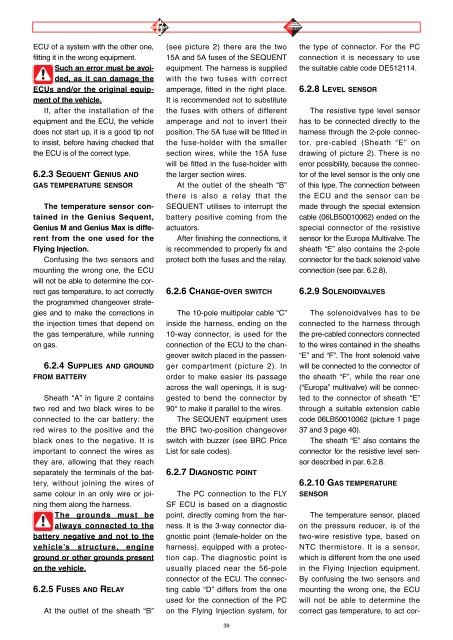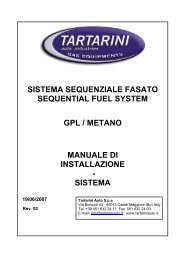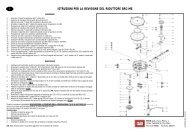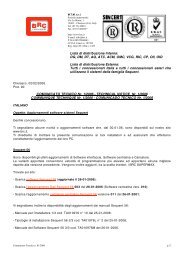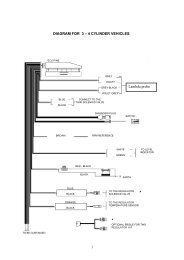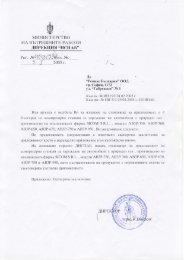Installer's handbook - 1/3 Types of installation - 2/3 Software guide ...
Installer's handbook - 1/3 Types of installation - 2/3 Software guide ...
Installer's handbook - 1/3 Types of installation - 2/3 Software guide ...
You also want an ePaper? Increase the reach of your titles
YUMPU automatically turns print PDFs into web optimized ePapers that Google loves.
ECU <strong>of</strong> a system with the other one,<br />
fitting it in the wrong equipment.<br />
Such an error must be avoided,<br />
as it can damage the<br />
ECUs and/or the original equipment<br />
<strong>of</strong> the vehicle.<br />
If, after the <strong>installation</strong> <strong>of</strong> the<br />
equipment and the ECU, the vehicle<br />
does not start up, it is a good tip not<br />
to insist, before having checked that<br />
the ECU is <strong>of</strong> the correct type.<br />
6.2.3 SEQUENT GENIUS AND<br />
GAS TEMPERATURE SENSOR<br />
The temperature sensor contained<br />
in the Genius Sequent,<br />
Genius M and Genius Max is different<br />
from the one used for the<br />
Flying Injection.<br />
Confusing the two sensors and<br />
mounting the wrong one, the ECU<br />
will not be able to determine the correct<br />
gas temperature, to act correctly<br />
the programmed changeover strategies<br />
and to make the corrections in<br />
the injection times that depend on<br />
the gas temperature, while running<br />
on gas.<br />
6.2.4 SUPPLIES AND GROUND<br />
FROM BATTERY<br />
Sheath “A” in figure 2 contains<br />
two red and two black wires to be<br />
connected to the car battery: the<br />
red wires to the positive and the<br />
black ones to the negative. It is<br />
important to connect the wires as<br />
they are, allowing that they reach<br />
separately the terminals <strong>of</strong> the battery,<br />
without joining the wires <strong>of</strong><br />
same colour in an only wire or joining<br />
them along the harness.<br />
The grounds must be<br />
always connected to the<br />
battery negative and not to the<br />
vehicle’s structure, engine<br />
ground or other grounds present<br />
on the vehicle.<br />
6.2.5 FUSES AND RELAY<br />
At the outlet <strong>of</strong> the sheath “B”<br />
(see picture 2) there are the two<br />
15A and 5A fuses <strong>of</strong> the SEQUENT<br />
equipment. The harness is supplied<br />
with the two fuses with correct<br />
amperage, fitted in the right place.<br />
It is recommended not to substitute<br />
the fuses with others <strong>of</strong> different<br />
amperage and not to invert their<br />
position. The 5A fuse will be fitted in<br />
the fuse-holder with the smaller<br />
section wires, while the 15A fuse<br />
will be fitted in the fuse-holder with<br />
the larger section wires.<br />
At the outlet <strong>of</strong> the sheath “B”<br />
there is also a relay that the<br />
SEQUENT utilises to interrupt the<br />
battery positive coming from the<br />
actuators.<br />
After finishing the connections, it<br />
is recommended to properly fix and<br />
protect both the fuses and the relay.<br />
6.2.6 CHANGE-OVER SWITCH<br />
The 10-pole multipolar cable “C”<br />
inside the harness, ending on the<br />
10-way connector, is used for the<br />
connection <strong>of</strong> the ECU to the changeover<br />
switch placed in the passenger<br />
compartment (picture 2). In<br />
order to make easier its passage<br />
across the wall openings, it is suggested<br />
to bend the connector by<br />
90° to make it parallel to the wires.<br />
The SEQUENT equipment uses<br />
the BRC two-position changeover<br />
switch with buzzer (see BRC Price<br />
List for sale codes).<br />
6.2.7 DIAGNOSTIC POINT<br />
The PC connection to the FLY<br />
SF ECU is based on a diagnostic<br />
point, directly coming from the harness.<br />
It is the 3-way connector diagnostic<br />
point (female-holder on the<br />
harness), equipped with a protection<br />
cap. The diagnostic point is<br />
usually placed near the 56-pole<br />
connector <strong>of</strong> the ECU. The connecting<br />
cable “D” differs from the one<br />
used for the connection <strong>of</strong> the PC<br />
on the Flying Injection system, for<br />
39<br />
the type <strong>of</strong> connector. For the PC<br />
connection it is necessary to use<br />
the suitable cable code DE512114.<br />
6.2.8 LEVEL SENSOR<br />
The resistive type level sensor<br />
has to be connected directly to the<br />
harness through the 2-pole connector,<br />
pre-cabled (Sheath “E” on<br />
drawing <strong>of</strong> picture 2). There is no<br />
error possibility, because the connector<br />
<strong>of</strong> the level sensor is the only one<br />
<strong>of</strong> this type. The connection between<br />
the ECU and the sensor can be<br />
made through the special extension<br />
cable (06LB50010062) ended on the<br />
special connector <strong>of</strong> the resistive<br />
sensor for the Europa Multivalve. The<br />
sheath “E” also contains the 2-pole<br />
connector for the back solenoid valve<br />
connection (see par. 6.2.8).<br />
6.2.9 SOLENOIDVALVES<br />
The solenoidvalves has to be<br />
connected to the harness through<br />
the pre-cabled connectors connected<br />
to the wires contained in the sheaths<br />
“E” and “F”. The front solenoid valve<br />
will be connected to the connector <strong>of</strong><br />
the sheath “F”, while the rear one<br />
(“Europa” multivalve) will be connected<br />
to the connector <strong>of</strong> sheath “E”<br />
through a suitable extension cable<br />
code 06LB50010062 (picture 1 page<br />
37 and 3 page 40).<br />
The sheath “E” also contains the<br />
connector for the resistive level sensor<br />
described in par. 6.2.8.<br />
6.2.10 GAS TEMPERATURE<br />
SENSOR<br />
The temperature sensor, placed<br />
on the pressure reducer, is <strong>of</strong> the<br />
two-wire resistive type, based on<br />
NTC thermistore. It is a sensor,<br />
which is different from the one used<br />
in the Flying Injection equipment.<br />
By confusing the two sensors and<br />
mounting the wrong one, the ECU<br />
will not be able to determine the<br />
correct gas temperature, to act cor-


